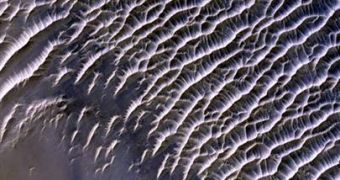The latest images sent by the Martian human-made explorers and orbiters show, in more detail, how the sand ripples scar the planet's surface in some regions, which allows scientists to build up on their existing theories related to their formation, or to come up with entirely new ones. Yet, as we lack more accurate data, we're still in the realm of presumption. The ripples are not to be mistaken for the huge Martian dunes, as they are much smaller in dimension, but still larger than any sand ripple on the surface of the Earth.
The Transverse Aeolian Ridges (TARs), as they have been named, are believed to have formed by the activity of the wind, and come in many forms, regular, forked, sinuous, overlapping, etc., from the simplest to the most complex. They can hint at the past events that happened on the planetary surface and led to their creation, but a more complex analysis, relying on their composition and structure, could also aid future missions, be they manned or robotic, in case of an encounter with a formation of this sort. For instance, three years ago, the Mars Exploration Rover named Opportunity got stuck in such a ridge for six weeks.
The event proved to be fortuitous, though, since the rover was given an opportunity (feel the irony?) to study the respective TAR. The results indicated that it comprised an external layer of tiny granules, between 0.08 inches (2 millimeters) to 0.2 inches (5 millimeters) in size, which covered a mass of finer, coarse particles. Such TARs are found to be more common around the equator, with a predilection for the Southern Hemisphere (especially in craters), like in the Meridiani Planum, for example, either close to a layered terrain or next to the Large Dark Dunes (LDDs).
According to Matt Balme from the Planetary Science Institute in Tucson, Arizona, TARs form with the help of sedimentary material and winds. Referring to the different age of TARs, Balme said that, “My theory is that the very young TARs are found near the Large Dark Dunes, which are also very young, because the sand blowing off the dunes provides the energy needed to form TARs. Meanwhile you have areas near layered landforms that used to have active sediment transport, but no longer [do]. This shows a dynamic environment that has changed, and we might be able to use TARs as paleo-markers to help decipher ancient climates.”
Current data doesn't provide any clues regarding a major change in the atmosphere of Mars and wind patterns, which would explain why there are no more winds on the planet today. “But I think the geology we are seeing suggests that there might have been different patterns and densities,” shared Balme. “The observations we're getting now from Mars Global Surveyor [data analysis] and the HiRISE camera (flying aboard the Mars Reconnaissance Orbiter [currently orbiting Mars]) are giving us really good data to drive the models. Over the next couple of years we should be seeing many more images from HiRISE that can give us more information, for example, about the heights versus spacing and whether TARs have more in common with dunes or the ripple fields found on Earth.”

 14 DAY TRIAL //
14 DAY TRIAL //